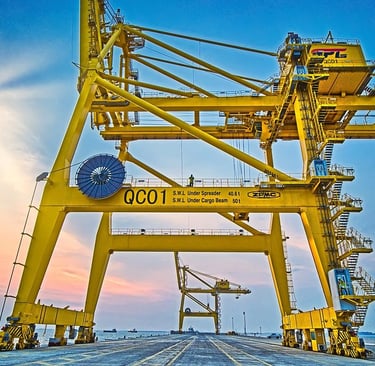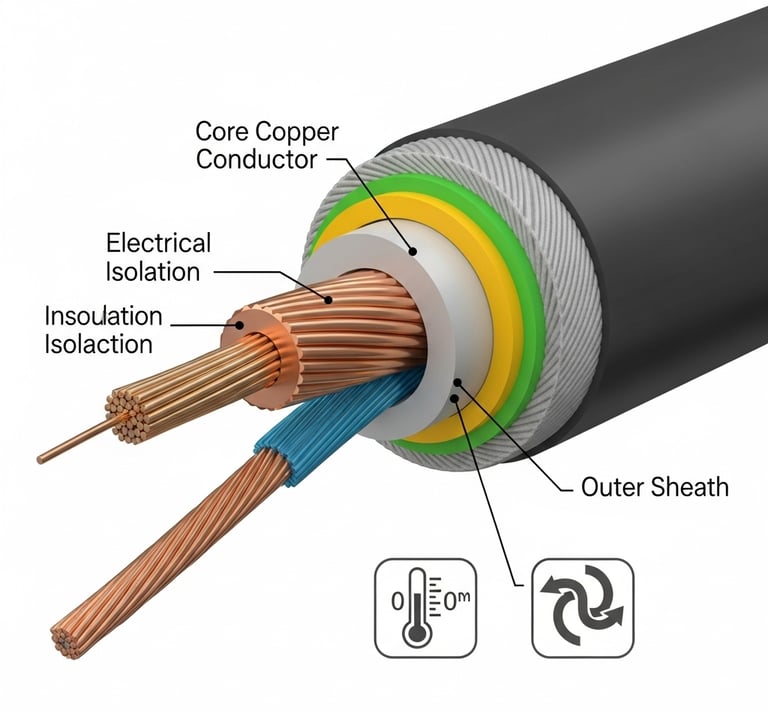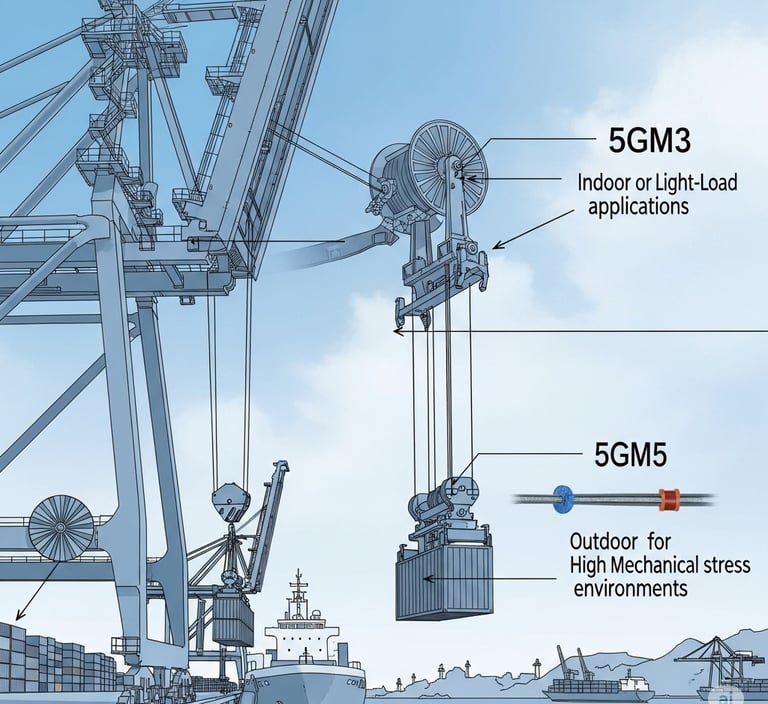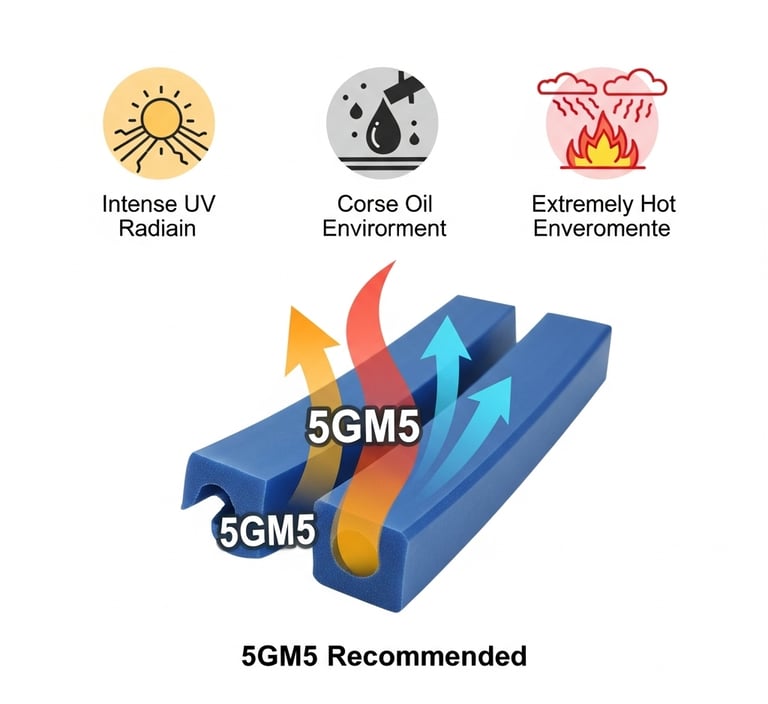📞+86 153 7530 2641 📧 hongjing.Wang@feichuncables.com
What’s the Difference Between 5GM3 and 5GM5 in Port Crane Cables?
Discover the key differences between 5GM3 and 5GM5 rubber sheathing in port crane cables. Learn how their mechanical properties, temperature resistance, and flexibility affect cable performance in heavy-duty lifting operations.
hongjing.Wang@Feichun
7/17/20257 min read


Port operations demand exceptional reliability from their electrical infrastructure, particularly in the heavy-duty lifting equipment that forms the backbone of modern cargo handling. Port crane cables represent one of the most critical components in these systems, subjected to constant mechanical stress, extreme weather conditions, and demanding operational cycles that can span decades. The choice of rubber sheathing material directly impacts cable performance, safety, and operational costs.
Among the various rubber compounds available for port crane cables, 5GM3 and 5GM5 ethylene-propylene rubber (EPR) formulations have emerged as industry standards. Understanding the difference between 5GM3 and 5GM5 in crane cables is essential for engineers, procurement specialists, and maintenance teams responsible for ensuring reliable power transmission in heavy-duty cable applications. This comprehensive analysis explores how these two rubber sheathing materials perform across different scenarios, helping stakeholders make informed decisions about their port crane cable solutions.
What Are 5GM3 and 5GM5?
The 5GM3 rubber compound represents a standard-grade ethylene-propylene rubber (EPR) formulation specifically engineered for industrial cable applications. This material combines ethylene and propylene polymers with carefully selected additives to create a rubber sheath that provides adequate protection for cables in moderate operating conditions. The 5GM3 insulation material meets basic industrial requirements for mechanical protection, weather resistance, and electrical insulation properties.
In contrast, 5GM5 represents an enhanced-grade ethylene-propylene rubber formulation that incorporates advanced polymer chemistry and specialized additives to achieve superior performance characteristics. This EPR sheathing material is designed for more demanding applications where standard rubber compounds may prove insufficient. The 5GM5 rubber compound offers enhanced mechanical properties, improved temperature resistance, and better long-term durability compared to its 5GM3 counterpart.
Both materials are manufactured to comply with international standards including DIN VDE specifications and IEC requirements for rubber-insulated cables. These standards ensure consistent quality and performance across different manufacturers while providing engineers with reliable specifications for cable selection and system design.


Key Differences Between 5GM3 and 5GM5
Temperature Resistance
Temperature performance represents one of the most significant distinctions between these two rubber compounds. The 5GM3 formulation typically operates within a temperature range of +60°C to +80°C maximum, making it suitable for indoor applications and moderate climate conditions. This temperature rating covers most standard industrial applications where ambient temperatures remain relatively stable.
The 5GM5 material demonstrates superior high-temperature sheathing capabilities, maintaining its mechanical and electrical properties at temperatures up to +90°C. This enhanced temperature resistance makes 5GM5 the preferred choice for outdoor installations, particularly in regions with extreme summer temperatures or applications where cables may be exposed to heat sources from machinery or direct sunlight.
Mechanical Strength and Abrasion Resistance
Mechanical durability differentiates these materials significantly in heavy-duty applications. The 5GM5 formulation incorporates reinforcement additives that provide superior tear resistance and tensile strength compared to 5GM3. This enhanced mechanical performance translates to better resistance against physical damage from sharp edges, heavy loads, and mechanical stress during cable installation and operation.
The abrasion-resistant rubber properties of 5GM5 make it particularly valuable in applications where cables experience frequent contact with metal surfaces, concrete structures, or other abrasive materials. Port crane environments often present these challenging conditions, where cables may rub against guide rails, support structures, or other equipment during normal operation.
Flexibility and Bending Radius
Flexibility characteristics present an interesting trade-off between these materials. The 5GM3 compound generally offers greater flexibility, allowing for tighter bending radii and easier installation in confined spaces. This flexible crane cable property makes 5GM3 advantageous in applications where space constraints require compact cable routing or where frequent manual handling is necessary.
The 5GM5 material, while slightly less flexible than 5GM3, provides better performance in dynamic applications where cables experience repeated bending cycles. This characteristic makes 5GM5 preferred for festoon cable systems and reeling applications where cables must maintain their integrity through thousands of operational cycles.
Application Scenarios in Port Cranes
Indoor Versus Outdoor Applications
Indoor port crane installations typically favor 5GM3 rubber sheathing due to the controlled environment and moderate temperature conditions. Warehouse cranes, container stacking systems, and covered loading areas provide protection from UV radiation, extreme temperatures, and weather-related stress factors. In these applications, the cost-effectiveness and adequate performance of 5GM3 make it an optimal choice.
Outdoor port crane installations present more challenging conditions that often justify the enhanced properties of 5GM5. Quayside cranes, ship-to-shore gantries, and rubber-tired gantry cranes face constant exposure to saltwater spray, UV radiation, temperature extremes, and ozone degradation. The UV-resistant rubber cable properties of 5GM5 provide superior long-term performance in these harsh environments.
Festoon and Reeling Systems
Festoon cable systems require materials that can withstand constant movement and mechanical stress. The 5GM5 formulation excels in these applications due to its superior mechanical properties and resistance to fatigue cracking. The enhanced tear resistance prevents cable damage during rapid acceleration and deceleration cycles common in modern port crane operations.
Reeling cable for cranes presents unique challenges related to drum winding and unwinding operations. The 5GM5 material's improved abrasion resistance helps prevent surface damage during drum contact, while its enhanced temperature resistance accommodates the heat generated during high-speed reeling operations. These properties contribute to extended cable life and reduced maintenance requirements.
Environmental Stress Factors
Port environments subject cables to numerous stress factors that affect material selection. Salt spray accelerates corrosion and degradation of rubber compounds, making the enhanced chemical resistance of 5GM5 valuable for marine applications. Ozone exposure, common in coastal environments, can cause cracking and deterioration in standard rubber compounds, while 5GM5 formulations include ozone-resistant additives.
Oil exposure from hydraulic systems and machinery requires careful material selection. Both 5GM3 and 5GM5 offer adequate oil resistance, but 5GM5 provides better long-term performance when exposed to hydraulic fluids and lubricants commonly found in port crane systems.
How to Choose Between 5GM3 and 5GM5?
Mechanical Stress Assessment
The selection process begins with evaluating the mechanical stress levels in the specific application. High-stress environments with frequent cable movement, heavy loads, or potential impact damage favor 5GM5 due to its superior mechanical properties. Applications with minimal mechanical stress and controlled environments may achieve adequate performance with 5GM3 at lower cost.
Consider the operational cycle frequency and duration. Continuous operation with frequent starts and stops generates more mechanical stress than intermittent operation, potentially justifying the enhanced properties of 5GM5. The selecting crane cable process should account for peak stress conditions rather than average operating conditions.
Climate and Environmental Considerations
Regional climate conditions significantly influence material selection. Tropical and subtropical ports with high temperatures and UV exposure benefit from 5GM5's enhanced temperature resistance and UV stability. Temperate climates with moderate conditions may achieve satisfactory performance with 5GM3.
Environmental contamination levels also affect material choice. Ports with high levels of airborne pollutants, chemical exposure, or industrial contamination may require the enhanced chemical resistance of 5GM5. Clean environments with minimal contamination can often utilize 5GM3 effectively.
Lifecycle and Maintenance Considerations
Total cost of ownership calculations should include initial material costs, installation expenses, maintenance requirements, and expected service life. While 5GM5 commands a higher initial cost, its enhanced durability may result in lower total costs over the cable's operational life through reduced maintenance and replacement frequency.
The rubber sheath comparison must consider maintenance accessibility and replacement costs. Applications where cable replacement is difficult or expensive may justify the premium cost of 5GM5 to extend service intervals and reduce maintenance requirements.




Frequently Asked Questions
Q: What environmental problems do port crane cables face, and how do 5GM3 and 5GM5 materials address these challenges?
A: Port crane cables encounter several environmental challenges including saltwater corrosion, UV degradation, ozone exposure, extreme temperatures, and oil contamination. The 5GM3 material provides adequate protection in moderate environments but may degrade more quickly under severe conditions. The 5GM5 formulation incorporates enhanced additives for UV resistance, ozone protection, and improved chemical resistance, making it more suitable for harsh marine environments where cables face constant exposure to salt spray and extreme weather conditions.
Q: How do temperature fluctuations affect the performance of 5GM3 versus 5GM5 rubber compounds in port applications?
A: Temperature fluctuations significantly impact rubber compound performance and longevity. The 5GM3 material maintains adequate flexibility and insulation properties within its rated temperature range of +60°C to +80°C but may become brittle or soft beyond these limits. The 5GM5 compound withstands higher temperatures up to +90°C while maintaining stable mechanical properties across wider temperature ranges. This enhanced temperature stability makes 5GM5 more suitable for outdoor applications where cables experience daily temperature cycles and seasonal extremes.
Q: Which material is more cost-effective for different port crane applications?
A: Cost-effectiveness depends on the specific application requirements and environmental conditions. For indoor or protected environments with moderate mechanical stress, 5GM3 often provides adequate performance at lower initial cost. However, for outdoor installations, high-stress applications, or environments with extreme conditions, 5GM5's enhanced durability and longer service life may result in lower total cost of ownership despite higher initial investment. The decision should be based on comprehensive lifecycle cost analysis rather than initial purchase price alone.
Conclusion
The choice between 5GM3 and 5GM5 rubber sheathing materials for port crane cables requires careful consideration of operational requirements, environmental conditions, and long-term performance expectations. While 5GM3 offers adequate performance for moderate applications at lower cost, 5GM5 provides superior mechanical properties, temperature resistance, and environmental durability for demanding port crane applications.
The difference between 5GM3 and 5GM5 in crane cables extends beyond simple material specifications to encompass total system performance and operational reliability. Engineers and procurement specialists must evaluate specific application requirements, environmental conditions, and lifecycle costs to make informed decisions about EPR cable materials.
For buyers and design engineers, the key lies in matching material properties to application demands rather than defaulting to lowest-cost options. The enhanced performance characteristics of 5GM5 justify their premium cost in applications where cable failure could result in significant operational disruptions or safety concerns. Conversely, 5GM3 remains an excellent choice for applications where its performance characteristics meet operational requirements.
The future of port crane cable solutions depends on continued advancement in rubber compound technology and deeper understanding of how these materials perform in real-world applications. As ports continue to increase operational intensity and equipment complexity, the role of high-performance EPR cable materials like 5GM5 becomes increasingly important in ensuring reliable, safe, and cost-effective operations.
Success in port crane cable selection requires balancing initial costs against long-term performance, considering both immediate operational needs and future expansion requirements. By understanding the fundamental differences between these industrial rubber sheathing materials, stakeholders can make decisions that optimize both performance and cost-effectiveness in their specific applications.
How to Reach Us
Get in Touch
SiteMap
Product Catalogue
Reeling Cable
Festoon Cable
Shore Power Cable




Scan to add us on WeChat
